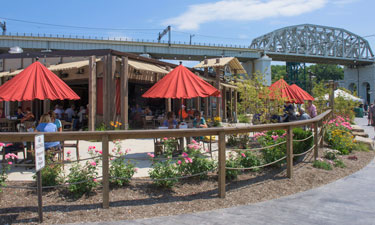 Cleveland Metroparks is well known for its 23,000 acres of meadows, wetlands, rivers and forests ringing the suburbs of Cleveland. But, in the last few years, chartered by a new strategic plan, the park district has enthusiastically made inroads to better serve urban residents. Urban spaces can offer unconventional challenges and require creative solutions beyond the boundaries of normal operations. Rivergate Park, located in Cleveland’s industrial Flats area, was one such space.
Cleveland Metroparks is well known for its 23,000 acres of meadows, wetlands, rivers and forests ringing the suburbs of Cleveland. But, in the last few years, chartered by a new strategic plan, the park district has enthusiastically made inroads to better serve urban residents. Urban spaces can offer unconventional challenges and require creative solutions beyond the boundaries of normal operations. Rivergate Park, located in Cleveland’s industrial Flats area, was one such space.
Seven acres of desolate pavement and gravel hidden away in an old industrial area next to the Cuyahoga River shipping channel, Rivergate Park did not have the obvious makings of a park. The land, formerly used for boat storage, was empty but for two drab, pre-engineered steel buildings. No grass or trees grew there, and the dredged shipping channel was busy with enormous bulk freighters carrying industrial materials. For several years, the space challenged the imaginations of many who tried to envision it as a park.
But, this scrappy piece of land could provide something found almost nowhere else in Cleveland: public access to the Cuyahoga River. It is centrally located close to the 110-mile Towpath Trail that stretches from the heart of Cleveland to central Ohio. Land-use planners envisioned park space for urban residents, water recreation and economic development, but the will and the funding were not yet there.
In 2008–2009, a series of serendipitous events moved plans forward: the price of commercial real estate dropped and the Cleveland Rowing Foundation (CRF) was seeking a bigger location. However, CRF only needed half the property, so it collaborated with the Trust for Public Land (TPL), and the two organizations purchased the entire parcel, valued at $6 million, for just $3 million.
Tying It Together
In 2013, Cleveland Metroparks CEO, Brian Zimmerman, was charged by a new strategic plan to bring more park services to the urban core. He quickly grasped the potential in that stark patch of pavement and steel buildings. The existing and potential entities on the site needed an agency such as Cleveland Metroparks to help tie them all together. The Ohio City Bicycle Co-op, serving the needs of the cycling community, had been operating on the edge of the property for many years. The city was looking for space to locate a long-promised skateboard park. CRF moved in and the Cleveland Dragon Boat Association was using the vacant parking lot. Cleveland Metroparks envisioned an urban park united around recreation, including rowing, paddling, skateboarding and bicycling, and connected by regional trails.
In an unusual twist, one vacant building on the property came with a liquor license, a coveted revenue-generating asset in Ohio where the number of such licenses is limited. In a departure from typical park and recreation practices, the park district transformed the building into the full-service, riverfront Merwin’s Wharf Restaurant that it owns and manages.
An important component of the restaurant is connecting people with the long-neglected Cuyahoga River. Diners enjoy close-up views of giant freighters plying the waters. Dwarfed by the freighters, paddlers, rowers and dragon boaters glide by. The paddlers can use the free public dock that was installed near the restaurant, and diners can take guided water taxi rides, while learning about the history and nature around them. They can also play games on the enormous riverfront patio. Occasional lectures on local culture and history fill the indoor meeting room with diners excited to learn more about Cleveland as they sample local fare.
Nearby, skaters, young and old, practice tricks in the skate park. Bikes are available to purchase for the price of your own labor at the bicycle co-op. Rowers from high school age to adult come and go in large groups each day. Every year, the Dragon Boat Festival and annual Regatta attract thousands to watch and cheer. Rivergate Park offers an innovative urban social space for active and passive recreation.
The Cuyahoga River — which burned on several occasions, most famously in 1969 — suffered from so much pollution and industrial use that access for recreation was not considered. But, the river is getting cleaner, Cleveland is diversifying its economy beyond industry, and Cleveland Metroparks is striving to provide better recreation and open space to urban residents. In a sign of growth, other businesses have sprung up along the road leading to Rivergate Park. This once dreary patch of pavement is now a bustling recreational hub with an impact on quality of life and economics. And, residents who can recreate in and around their once-neglected river are more likely to protect this natural resource.
In the last few years, Cleveland has seen a resurgence. Young professionals and empty nesters are flocking to the city and downtown residences are 97 percent occupied. The restaurant scene is eclectic, construction cranes dominate the skyline and local businesses thrive. Cleveland Metroparks has positioned itself as a leader in helping with the Cleveland renaissance by taking on unlikely challenges and offering non-traditional solutions to better serve urban populations with parks and recreation. Rivergate Park is a fine example of what can happen when a park district uses imagination and collaboration, finding new ways to serve new audiences.
Nancy Desmond, CPRP, is Director of Special Projects for Cleveland Metroparks.

